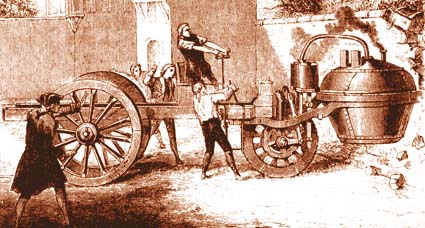Motor Cars
The first steam car

The first vehicle to move under its own power was designed by Nicholas Joseph Cugnot of France, and constructed by M. Brezin in 1769. Cugnot's vehicle used a steam engine to power his vehicle, travelling at a walking pace. It was used for towing cannon as well as carrying four people and from there we have seen a slow progression to what we have today. The speed of evolution was controlled by the pace at which technology progressed.
Steam engines (see Industrial Revolution) added so much weight to a vehicle that they proved a poor design for road vehicles; however, steam engines were very successfully used in locomotives (see Trains). Historians, who accept that early steam-powered road vehicles were automobiles, feel that Nicolas Cugnot was the inventor of the first automobile.
The first electric car

Steam engines were not the only engines used in early automobiles. Vehicles with electrical engines were also invented.
It is uncertain who invented the very first electrical vehicle but several inventors have been given credit. In 1828, Hungarian, Ányos Jedlik invented a small-scale model car powered by an electric motor that he designed. Between 1832 and 1839 (the exact year is uncertain), Robert Anderson of Scotland in the United Kingdom invented a crude electric-powered carriage. In 1835, another small-scale electric car was designed by Professor Stratingh of the Netherlands, and built by his assistant Christopher Becker. In 1835, Thomas Davenport, an American blacksmith, built a small-scale electric car.
Electric cars used rechargeable batteries that powered a small electric motor. The early electric car had a top speed of 20 mph. The vehicles were heavy, slow, expensive, and needed to stop for recharging frequently.
Both steam and electric road vehicles were abandoned in favor of gas-powered vehicles. Electricity found greater success in tramways and streetcars, where a constant supply of electricity was possible.
The first gas car

The first gasoline car was invented in 1870 by Austrian inventor Siegfried Marcus. The first Marcus car was more like a 4-wheel handcart for moving people and objects around. Marcus also invented the magento low voltage ignition system that would go into the 4-seat second Marcus car of 1888 and in other subsequent automobiles.
Another man who has a claim to the first gasoline car is Etienne Lenoir of France. Lenoir invented a hydrogen powered car in 1860 called the Hippomobile. Two years later he also claimed to have run a car on benzene, an oil derivative and if this is true, then his claim to have invented the first petroleum-powered car is correct.
In 1873, American engineer George Brayton developed a two-stroke kerosene engine and some consider this to be the first petroleum-powered car.
There are several others who are sometimes credited with inventing the first gasoline-powered car. Some of the names include Enrico Bernardi of Italy, who invented a one-cylinder motor on a tricycle and a motorcycle, Karl Benz of Germany and Gottlieb Daimler and Wilhelm Maybach also of Germany.
Gottlieb Daimler and Karl Benz both invented highly successful and practical gasoline-powered vehicles that ushered in the age of modern automobiles. Daimler and Benz invented cars that looked and worked like the cars we use today. Their cars used an internal combustion engine that used the explosive combustion of fuel to push a piston within a cylinder - the piston's movement turned a crankshaft that then turned the car wheels via a chain or a drive shaft.
Important pioneers

One of the most important landmarks in engine design comes from Nicolaus August Otto of Germany, who in 1876 invented an effective gas motor engine. Otto built the first practical four-stroke internal combustion engine called the "Otto Cycle Engine," and as soon as he had completed his engine, he built it into a motorcycle. Otto's contributions were very historically significant, it was his four-stoke engine that was universally adopted for all liquid-fueled automobiles going forward.
In 1885, German mechanical engineer, Karl Benz designed and built the world's first practical automobile to be powered by an internal-combustion engine. On January 29, 1886, Benz received the first patent (DRP No. 37435) for a three-wheeled gas-fueled car. Benz built his first four-wheeled car in 1891. Benz & Cie., the company started by the inventor, became the world's largest manufacturer of automobiles by 1900.
In 1885, Gottlieb Daimler (together with his design partner Wilhelm Maybach) took Otto's internal combustion engine a step further and patented what is generally recognized as the prototype of the modern gas engine.